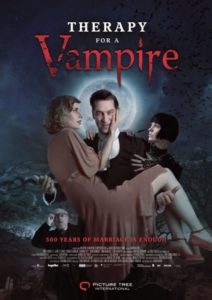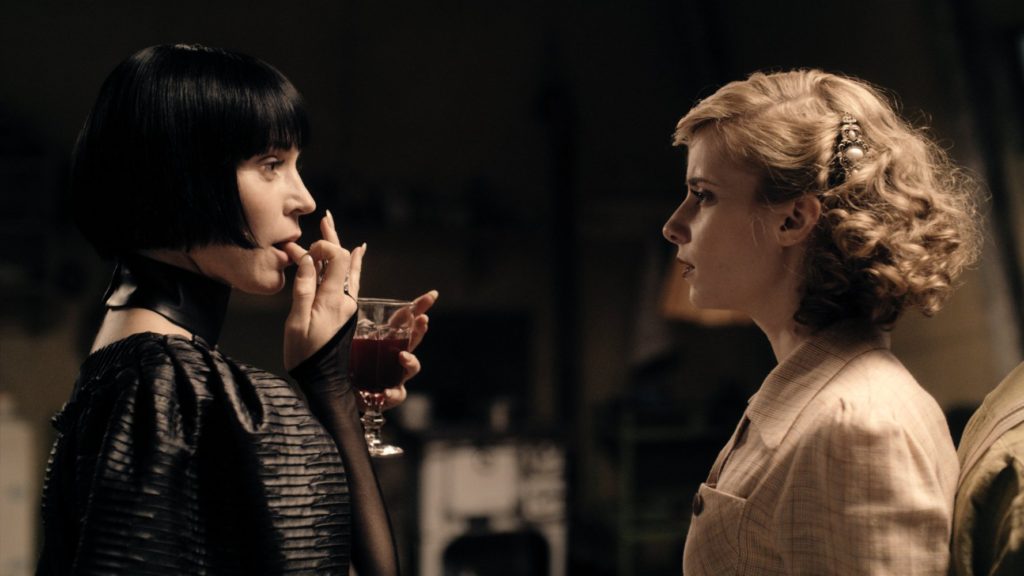The Count, The Painter, His 500-Year-Old Wife, And His Lover
DIRECTED BY DAVID RÜHM/GERMAN/2014
 After all these years, how many different ways can we honestly tell a vampire story?
After all these years, how many different ways can we honestly tell a vampire story?
How about a delightful romantic farce about a pair of undead so sick of each other after 500 years of marriage that the Count checks in for therapy with Sigmund Freud?
I’m in!
To be fair, there’s another married-vampire tale out there that’s received critical acclaim—Jim Jarmusch’s Only Lovers Left Alive—but as dour tales of depressed vampires don’t typically appeal to me, I skipped it. Therapy reminds me most of a different recent take on bloodsuckers, the also darkly comic What We Do In the Shadows. Both films feature characters who are, despite being blessed/cursed with immortality and great powers, still inescapably and absurdly human.
With one old and one young couple both bickering with and seducing each other, I could easily imagine the main cast tackling a rendition of Who’s Afraid of Virginia Woolf?
 Therapy puts us on familiar ground with creaking old gates, full moons, and a sophisticated European gentleman, Count Geza (Tobias Moretti), who’s grown bored with his existence. His wife Countess Elsa (Jeanette Hain) prowls the town, committing gory attacks on her prey with violent relish. Geza meets with Freud (a nicely deadpan Karl Fischer) to reflect upon his life, while Elsa despairs of never being able to see her own physical reflection. Elsa commissions an artist named Viktor (Dominic Oley) to paint her portrait so she can see herself, while Geza strikes up a romance with Viktor’s girlfriend, the spirited and appropriately named Lucy (Cornelia Ivancan).
Therapy puts us on familiar ground with creaking old gates, full moons, and a sophisticated European gentleman, Count Geza (Tobias Moretti), who’s grown bored with his existence. His wife Countess Elsa (Jeanette Hain) prowls the town, committing gory attacks on her prey with violent relish. Geza meets with Freud (a nicely deadpan Karl Fischer) to reflect upon his life, while Elsa despairs of never being able to see her own physical reflection. Elsa commissions an artist named Viktor (Dominic Oley) to paint her portrait so she can see herself, while Geza strikes up a romance with Viktor’s girlfriend, the spirited and appropriately named Lucy (Cornelia Ivancan).
With one old and one young couple both bickering with and seducing each other, I could easily imagine the main cast tackling a rendition of Who’s Afraid of Virginia Woolf?
The film itself looks elegant, with rich colors that liven up both the drama and the comedy, delivering all the visual flourishes we’d expect of a European vampire flick set in the 1930s, but never pushing it into parody. The effects work—vampire-to-beast transformations and such—are mostly kept off camera or seen in shadow, and enhanced through editing and well-crafted sound design. It’s the subtle touches and light gags that the director chooses that build his world and keep the farcical tone alive amidst all the blood and broken hearts. Even the punctuation of a fart joke and a zany pair of hypno-glasses don’t ruin the mood.
Therapy For a Vampire feels like the movie Tim Burton wanted Dark Shadows to be.
 I can’t stay that it completely milks its high concept—the therapy sessions are pretty much over by the first act—but none of the characters are wasted, and Lucy’s arc is thankfully driven more by her search for agency rather than the manipulations of her well-manicured predator.
I can’t stay that it completely milks its high concept—the therapy sessions are pretty much over by the first act—but none of the characters are wasted, and Lucy’s arc is thankfully driven more by her search for agency rather than the manipulations of her well-manicured predator.
And you know what else? It’s short, too—moving right into the story and gifting us with great little two-person scenes that always feel motivated by character, while tangling the plot into more and more entertaining farce in just under an hour-and-a-half. When many otherwise good flicks like the recent Conjuring sequel make me feel like I’ve been sitting there for 500 years, Therapy’s brief running time made for a quick but satisfying sip of fun, horror, and tragic love.

